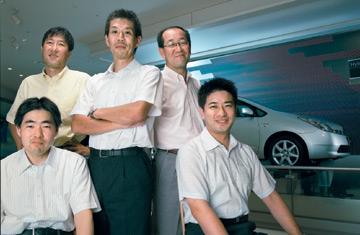
In late 1993, a handful of Toyota's top engineers and designers were charged with a modest task: create a completely new automobile for the 21st century. Even as U.S. consumers were falling in love with the gas-guzzling SUV, Toyota's brain trust felt that growing environmental concerns would trigger demand for low-emission automobiles. The team toyed with producing an improved conventional gasoline car, but dismissed the idea as insufficiently revolutionary. Instead, they decided on a gasoline-electric hybrid: what would become the Prius. "We had to invent something completely original," says Satoshi Ogiso, executive chief engineer for Toyota's product-planning division. "We'd have to build it from scratch, blueprint and all."
Easier planned than done. Ogiso's 10-person team ultimately swelled to thousands (five of them, including Ogiso, center, are pictured here). The biggest challenge was the battery — too small and it would lack power, too large and it would overheat. In 1995, the first prototype ran for 330 ft. (100 m) before going dead. But Toyota became the world's No. 1 car company on the strength of its monozukuri, or manufacturing vision, and by October 1997 the first Prius was available in Japan. It went on to sell over 800,000 units worldwide, gilding Toyota's corporate image and emerging as the foremost status symbol of the green consumer movement. "There are people who want to do good, and people who want everyone else to know they do good," says Daniel Sperling, director of the Institute of Transportation Studies at the University of California, Davis. "The genius of the Prius is that it captured both."
The Prius has been dismissed — especially by its trailing American competitors — as a triumph of marketing rather than technology. But it would be a mistake to underestimate its impact — or the skill of the engineers who built it. "Corporate engineers usually get frustrated because we wonder if all the hard work is meaningful," says Ogiso. "But [this] was a project worthy of the challenges and the difficulties." It's the Toyota way — and as the need for innovation grows, perhaps the way ahead for all of us.